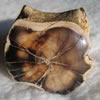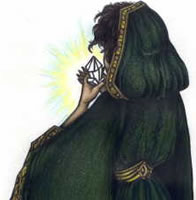|
|
Stone Whisperer Newsletter
|
| April 10, 2009 |
Full Moon – Sprouting Grass Moon
|
Intro
As I stated in last month’s newsletter, this time I want to talk
about fossils and the different properties they have. I learned some
new things about these fascinating artifacts we call fossils, particularly
about their individual properties, while writing this newsletter. And
there’s nothing better for a curious mind than to learn something
new and exciting. Hopefully you will find this information as interesting
as I did. And maybe, if you get the opportunity, you can go find some
of your own fossilized treasures.
Blessings to all!
~~~Alicia
Geology & Paleontology
Our Earth is approximately 4600 million years old, that’s 4,600,000,000
years old. The Earth’s history is divided into 4 major eras of
geologic time: the Precambrian (which is the oldest), the Paleozoic
(meaning “ancient life”), the Mesozoic (meaning “middle
life”), and the Cenozoic (meaning “recent life”).
There was no dominant form of life during the Precambrian Era until
the dawn of algae, making algal fossils some of the oldest on Earth.
The Paleozoic Era was dominated by life in the ancient seas, the Mesozoic
Era by reptiles, and the Cenozoic Era (the time in which humans live)
is dominated by mammals. Each era can be divided into distinct geological
periods, and even those can be further sub-divided. All periods and
eras can contain fossils specific to their time period.
Fossils are defined as any evidence of past life, not just the
preserved bones of vertebrate animals. For example, Stromatolites
are fossilized remains of algal mounds that date to the Precambrian
Era. They are the oldest known macroscopic fossils found on Earth. I
and two friends had the chance to see a giant Stomatolite mound near
Marquette, in Michigan’s U.P. a couple years ago. Stromatolites
can even be cut and polished, and worn as jewelry or carried in a pocket.
There are 2 main types of fossils: body fossils, which
include unaltered remains – where the entire organism or
skeletal structure of an organism is preserved -- and altered
remains – which include carbonization, permineralization,
and petrification -- and trace fossils.
Body Fossils – Unaltered:
Unaltered remains are fairly straight forward. They are the remains
of an entire animal, like the fossils of Ice Age animals in the La Brea
Tar Pits in California, a preserved skeleton of a dinosaur, or an insect
in Amber resin.
|
Did you know.....that a sedimentary rock formation rich
in fossil evidence, and that often yields exceptional finds, is called
a Lagerstatte, plural: Lagerstatten, which translated
from German, means literally "place of storage".
Zircon is the oldest known terrestrial mineral.
Gneiss (pronounced “nice”) is the oldest known rock on
Earth.
Meteorites are the oldest known things found on Earth, although they
are extraterrestrial in origin.
Komatiite was the first rock ever formed on Earth. You can see a
good example of Komatiite along the shoreline of Marathon, Ontario,
Canada.
Peridotite is the most common rock found on Earth, followed by Granite,
being the next most abundant.
Quartz is the most common mineral on Earth.
Additional Sources
The Book of Stones by Robert Simmons & Naisha Ahsian.
2005, 2007.
The Farmer's Almanac 2009.
Crystal Enhancements by D.J. Conway.
EarthLore shop, Livonia & Plymouth, Michigan.
Historical Geology taught by Jim Rexius. 2007.
Help me identify this fossil found in Northern
Ohio


If you think you know what this is, email
me.
|

Lophophyllum (horn) coral,
found in Ohio.
|

Favosites alpensis coral,
found in Michigan.
|

Brachiopod,
species Muscrospirifer,
found in Ohio.
|
Body Fossils – Altered:
Altered remains are just that, altered, changed in some way at the mineral
and/or chemical level during their preservation. Fossilization is a
tricky business, as the dead organism must be preserved rather quickly
and must remain undisturbed for ideal preservation to occur. This is
why complete skeletons are rarely found, and fossils are often damaged
or distorted when they are unearthed. The Earth is living organism itself,
or rather Herself, and is in constant motion, always changing and evolving.
All this movement causes remains of deceased animals and plants to be
disrupted and perfect fossilization is not always possible. So finding
any fossil, especially a beautifully preserved specimen is a very special
thing.
Carbonization occurs when all the other chemical elements of
a once-living carbon based organism are chemically removed after death,
leaving only carbon remaining. It happens in a non-oxygen rich environment
where the oxygen atoms detach from the carbon atoms and are forced to
escape out into the atmosphere. The hydrogen atoms are also released
and escape out into space. Only the carbon atoms remain creating a fossil.
An excellent example of carbonization is a fossilized plant, like a
prehistoric fern, preserved as a black imprint on shale.
Permineralization occurs when sediment fills in the open parts
of an animal (like a coral colony) after death, and it becomes fossilized.
This usually renders well preserved but often delicate specimens, as
sometimes the sedimentary rock is fragile.
|

Cylindrophyllum coral, species Coelenterata thamnopora, found in Ohio.
|
Petrification, also called replacement, occurs when the
organic matter becomes replaced by an inorganic substance like silica
or quartz. A good example of this process is Petrified Wood.
The wood has not “changed into” a mineral, is but rather “replaced
by” a mineral. This tends to render resilient specimens, as the
replacing mineral is more durable than the former organic substance
the tree was made of while it was alive. Common minerals that replace
organic matter are: Agate, Calcite, Dolomite, Opal, Pyrite, and Quartz.
Some of the most beautiful fossils of ancient trees are opalized petrified
wood.
Trace Fossils:
Trace fossils are indirect forms of preservation. They include: bioherms,
bioturbation, casts, coprolites, gastroliths, imprints, and tool
marks.
Bioherms are mounds of preserved sediment piled up by ancient
organisms.
Bioturbation occurs when the evidence of movement has been preserved.
A good example of this trace fossil is Tigillite , which is a
fossil created by ancient worms that dug holes in the ground. Their
tube-like burrows are preserved in the fossilized rock.
A cast is like the “reverse” of an imprint. It occurs
when an imprint fills in with a secondary mineral, making it a mirror
opposite of the original imprint.
A coprolite is fossilized animal dung. Dino poop! And, yes,
collectors actually buy this stuff!
A gastrolith is a stone that an animal once swallowed to aid
in digestion, then eliminated. A gastrolith (meaning “stomach stone”)
will appear rounded and smooth like a river rock. Collectors buy these
too!
An imprint is simply a mark made by an animal in the sediment,
like a mammoth footprint, for example. The sediment lithifies (becomes
compacted and solid, forming a sedimentary rock) and eventually forms
a trace fossil.
Tool marks are the fossilized evidence in rock of tools being
used by ancient organisms, like humans and our predecessors.
Some of the best fossil sites in Michigan are found at the upper part
of the Lower Peninsula. Our state stone, the Petoskey Stone,
is actually fossilized Hexagonaria Coral . Brachiopods, Bryozoans,
Cephalopods, various Corals, Crinoids, Graptolites, Peleceopods, and
Trilobites can all be found in the state. Michigan even has Mastodon
bones. I was lucky enough to go on two field trips with my geology classes
to Ohio and to the Alpena, Charlevoix, Petoskey, Roger’s City area
of Michigan to so some collecting. I was amazed that some of the best
fossils of small animals can be found at rock outcrops on the sides
of major highways. How many people drive past these rock piles day after
day without realizing there are millions of years old fossils out there,
within reach…?
|

Rough Petoskey stone, Hexagonaria coral,
found in Michigan.
|

Polished Petoskey stone, Michigan.
|
Magick & Healing Properties of
Fossils
All fossils have similar inherent properties. They all offer magical
protection. They all aid in past life recall. They all represent longevity,
perseverance, and the strength of life itself. Fossils correspond to
all 5 Elements (because the 4 physical Elements of Earth, Air, Fire,
and Water were involved in their creation, plus the Element of Spirit
for magickal qualities). They are a bridge to the worlds of magick and
shamanic healing.
Specific fossils do have added correspondences.
Ammonites – are a specific type of shelled animal from
the larger group of Cephalopods. Neolithic shamans used these spiral
shaped fossils in magick healing rituals relating to the Divine Feminine
and Earth Goddess worship. (The spiral is a sacred symbol of the Goddess,
and of the spiritual path to Enlightenment.) In ancient Egypt, Priestesses
and Priests associated them with Ram-headed deities because of their
resemblance to ram’s horns. In Mediaeval Europe they were known
as “Dragon Stones” because they were believed to have come
from the heads of dragons or monstrous serpents. Small ones were carried
as powerful magical tools for magicians. And large ones (some of these
animals were as large as a table or even a small car in the prehistoric
seas!) were revered as dragon relics. Ammonites teach us to follow the
spiral path of discovery and emerge at a new place of wisdom. Find your
spiritual path; at the center is the Goddess.
|
|

Polished Ammonite, Arizonia.
|
Coprolites – teach us about the kinship of all living things
on Earth.
Odontolite – is also called “Bone Turquoise”,
however it is not Turquoise. It is a fossilized tooth or bone that has
been colored a turquoise blue due to the presence of iron phosphate
and the mineral Vivianite. Odontolite helps us to bring what we need
into manifestation.
Petrified Wood – is one of the best stones for grounding
us to Earth’s energies. It connects us to the EarthStar Chakra,
the Soul of Mother Earth. Petrified wood teaches us patience, that a
slow pace is sometimes needed, “haste makes waste”, and steady
growth. It recalls the completion of the circle of life. It teaches
us that energy is neither created nor destroyed, just transformed. It
holds the memories of ancient life, and the wisdom of the sacred Old
Ones, the great prehistoric trees who can share their vast knowledge
with those who respect the Earth & Her treasures. It helps us get
to the “root” of a problem. It reminds us of the Earth’s
awesome beauty and power.
|

Petrified Wood, cross section
|

Petrified Wood
|
Sand Dollars (fossilized and modern) – are naturally occurring
pentacles. They are best used in spell-work when calling on all 5 Elements:
Earth, Air, Fire, Water, and Spirit. They are powerful tools for Water
Witches and Sea Magicians. Sand Dollars have little bones inside them
that look like tiny birds or fairies. They teach us about the secrets
of magick, that power lies within ourselves as well as outside of ourselves.
Sponges (fossilized and modern) – help us to become in
touch with our emotions. They help to control wild or harmful emotional
behavior, and tame hot temperaments. They help us soak up compassion
and allow us to become more sensitive. They bring subconscious thought
to the surface.
Stromatolites – aid in stress relief. They help us to realign
the natural flow of chi in the body. Use with Quartz to enhance
the power in times of great stress and anxiety.
|

Stromatolite, polished.
|
Tigillite – is calming and healing. It reminds us we have
the power to create our own journey in life. It eases terror and fear
when you sense your survival is threatened. It is good to use in healing
rituals to banish fear after any type of accident.
Turitella Agate – helps us to adjust to the new, to abrupt
changes in life, and to unexpected experiences.
|
|
|
|
|
|
|















